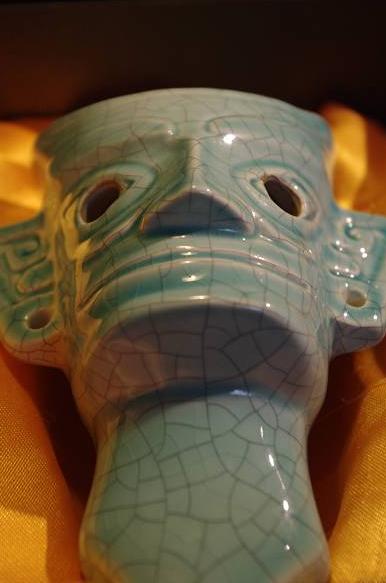It's time for ocarinas--Old-school instruments get a new life
| Ocarinas come in various shapes and sizes. |
Although it is probably most recognizable to most people today from its appearance in 1998's Zelda: Ocarina of Time, the ancient wind instrument is making a surprising comeback among Beijing music aficionados.
Originally an oval wooden flute consisting of just a mouthpiece and 4 to 12 finger holes, the ocarina or taodi has over time been modified to include different shapes and even materials, as can be seen in the 798 Art District's Ocarina Commune (Taodigongshe), which sells more than 300 different kinds.
Here you will find the Cheongsam-like ocarina, the one shaped like a ladybug, another decorated with Chinese landscape paintings and even ocarina showing the culture of Sanxingdui archaeological artifacts.
Ocarina mysterious past
The 12-hole instrument originated in Italy over 200 years ago, invented by an Italian named Giuseppe Donati and resembles an animal(the word ocarina means "little goose").
The Chinese xun is the original ceramic version. Though there are differences between the ocarina and xun - the ocarina uses an internal duct while the xun is blown across the outer edge - to some extent, they are homogenous musical instruments, although the former is still relatively new to China. The pendant version became popular in Taiwan and is now widespread in Chinese mainland.
There are many different styles of ocarina varying in shape and the number of blowholes, such as transverse (12-holes), pendant (6-holes), double and triple ocarinas. Multi-chambered ocarinas overcame the disadvantage of a limited range of notes. A transverse triple ocarina, for example, plays with a range about 2 octaves + 7 notes.
Zhou Zilei, founder of Ocarina Commune (taodigongshe), told Lifestyle, "Since the xun has played such an important role in our long history of over 3,000 years, there is still a huge potential in the taodi market. The development of taodi was limited by the manufacturing craft of the instruments. However, as the crafts are [now] exquisite and fine, the quality of sound and accuracy of pitch can be guaranteed."
Play whatever music you want
We saw lots of customers attracted by the melodious ocarina sound coming from Taodigongshe. Liu Yunqing is a habitual visitor Since she came across it a month ago. "When I first came here, two girls were playing the 'Moon River of Ono Lisa' on the taodi," she recalled. "Frankly speaking, I was really shocked by the beautiful sound of the instrument. It's so different from the sound of the guitar, flute, or piano."
Naturally, people have different views and preference of music, but what may surprise you is, that ocarina is adaptable to play whatever music you want, be it folk music, jazz, blues, pop and even rock. Sometimes merely sitting in the Ocarina Commune is a pleasure in itself, as the shop assistants are always trying out different kinds of music - you might hear the mellow vibes of Joe Hisaishi, the classical music of J.S. Bach, a foot-tapping pop music hit or a show tune from The Lion King.
"I have been playing the taodi for just one month so far, but I can [already] play the songs of my favorite singers, such as Keren Ann and Taylor Swift," Liu enthused. "Perhaps the most magical thing about the taodi is that you can learn to play a simple piece of music within about 10 minutes. You needn't know complicated music theory or tricky fingering: Everyone can do it!"
 0
0 









Go to Forum >>0 Comments